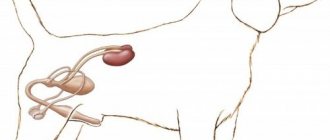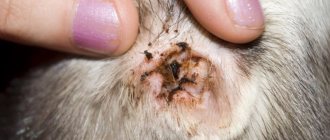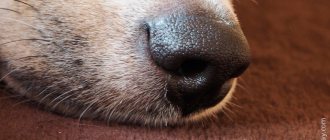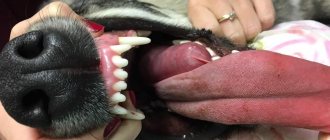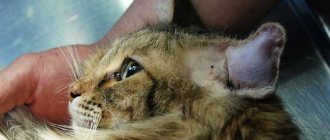What is stomatitis?
Stomatitis is a clinical syndrome that is expressed by inflammation of the oral mucosa. Problem areas in dogs look like round, reddish sores. As the process progresses, the ulcers become necrotic and become white. The gum tissue, mucous membranes of the cheeks and palate, larynx, back of the mouth and tongue area are affected.
Some forms of stomatitis manifest as an excessive immune reaction of oral tissues to bacteria and plaque proteins. In such cases, the disease becomes chronic and when the immune system is weakened or other diseases develop, a relapse will occur.
Treatment of stomatitis
Treatment of stomatitis in a dog must begin with the removal from the diet of foods that cause damage to the oral mucosa. For this purpose, a sick dog is prescribed chicken, beef or fish broths, slimy liquid porridges, jelly, milk, kefir, yogurt, acidophilus. In the case where the injury to the mucous membrane is severe and deep, the dog can be put on a fasting diet for 24-48 hours, but the dog must have free access to water. In such cases, the dog is given artificial nutrition using intravenous and subcutaneous injections of physiological solutions, blood and plasma substitutes, vitamins, and nutritional enemas.
To disinfect the oral cavity, use aqueous solutions in low concentrations of potassium permanganate (1: 10000), ethacridine lactate (1:1000), 3% solution of boric acid or furacilin (1:10000). Irrigation of the oral cavity with decoctions and infusions of medicinal herbs - chamomile, calendula, string, sage, coltsfoot, etc., has a more gentle effect. Irrigation of the oral cavity with the indicated means is carried out using a rubber bulb, a disposable syringe, or by lubricating it with the indicated substances, first applied to a cotton or bandage swab.
For the treatment and cauterization of deep ulcers and wounds, a solution of iodine with glycerin (1:4), 0.2% solution of silver nitrite (lapis), 0.1% solution of flavocridine hydrochloride, 1-2% solution of copper sulfate, syntomycin emulsion is used. and etc.
If indicated, the dog is additionally prescribed antibiotics.
Types of disease
Based on the origin of the disease, stomatitis is divided into:
- Primary, when inflammation occurs due to direct damage to the mucous membrane of the mouth or tongue.
- Secondary, if the pathology is one of the accompanying symptoms of the main, more serious disease: viral infection, severe kidney damage (uremic stomatitis).
Based on the location of the affected areas, the following are distinguished:
- glossitis (tongue tissue is affected);
- sublingual (inflammation under the tongue);
- gingival (on the gum);
- buccal (on the buccal surface);
- caudal (on the back surface of the mucous membranes of the oral cavity).
Based on the nature of the inflammatory process, lesions are divided into:
- Catarrhal. It is the initial stage of any inflammation. It looks like a thickened, reddened area. It can be single or multiple, covering different parts of the oral cavity.
- Vesicular. It is characterized by the appearance of small blisters, when damaged, wounds with a pronounced inflammatory process are formed. The affected areas can grow and merge (if the vesicles were located nearby).
- Erosive-ulcerative stomatitis in dogs develops with inflammation of damaged areas of the mucous membrane (including the next form of the vesicular variety). Clearly defined ulcers form on the tissues, their surface is white, and the adjacent areas are hyperemic.
- Hyperplastic stomatitis. It is distinguished by the proliferation of tissues, most often found in the gum area.
Symptoms by type of pathology
The general symptoms of the disease include hyperemia of the gums and oral mucosa, pain, the presence of gray plaque, and bleeding. There is a significant increase in body temperature, lack of appetite, and weakness. The appearance of a putrid odor from the mouth, the presence of wounds on the oral cavity.
When a dog is sick, its body temperature rises.
According to the classification by type, symptoms may vary slightly.
Atrophic appearance
Atrophic stomatitis occurs as a result of improper care of the dog, as a result of exhaustion of the body or during the change of teeth.
- The mucous membrane becomes covered with bubbles, papillomas and blood wounds appear.
- When pressed, the animal feels pain.
- The appetite disappears due to the fact that the pain syndrome intensifies and the dog cannot eat.
The atrophic type of stomatitis is characterized by a lack of appetite.
Gangrenous or ulcerative appearance
Gangrenous or ulcerative stomatitis develops as a result of malnutrition, the development of infectious pathology, the growth of tumors, chronic stress, diseases of internal organs, hormonal imbalance, and a weakened immune system.
- This type is characterized by the main localization of the infection directly on the gums; the cheeks and tongue are less often affected.
- At this stage, open bleeding ulcers are observed, and tissue necrosis is noticeable in places.
- The affected area is colored bright red or grayish-blue.
With poor nutrition, gangrenous or ulcerative stomatitis occurs.
Catarrhal position
Catarrhal lesions occur as a result of tartar, trauma to the mucous membranes from sharp edges of the teeth, and inflammatory diseases of the digestive system.
- The catarrhal form has a mild course, so no severe symptoms are observed.
- The gums and upper part of the palate are red, swollen, and there may be a white coating.
- On palpation there is pain.
Catarrhal position is characterized by redness of the gums.
Phlegmonous appearance
The most dangerous type of disease is phlegmonous, which is expressed by purulent inflammation of the oral cavity and occurs as a result of complications of other forms due to improper care or lack of treatment.
It is fraught with complete loss of dentition and the development of sepsis.
With phlegmonous appearance, the dog's teeth begin to fall out.
Causes of stomatitis in dogs
The direct cause of inflammation can be:
- Permanent injury to the mucous membrane due to improper bite or dental growth.
- Feeding cold or very hot food.
- Violation of the integrity of tissues by any objects (bones, toys, sticks).
- Exposure to chemicals (household products, toxic drugs).
- Poor oral hygiene.
Also, stomatitis in dogs can appear as a consequence of any disease. Eg:
- dental pathologies (periodontitis, periodontal disease);
- infectious diseases (canine plague, leptospirosis);
- acute and chronic renal failure;
- diseases of the digestive tract;
- immunodeficiency states.
The chronic form of inflammation has a breed predisposition and is more common in representatives of:
- Maltese;
- Cavalier King Charles Spaniels;
- Labradors;
- miniature schnauzers;
- greyhounds.
Characteristic symptoms
Let's look at how the disease develops. At the first stage, the symptoms look like this:
- slight redness of the mucous membrane, a gray coating may appear;
- a putrid odor emanates from the animal;
- the dog becomes less active and sleeps constantly;
- the animal tries to rub its head against any objects, often sneezes, and behaves irritably.
If the animal is not treated, the second stage will begin:
- the dog's body temperature rises;
- A large amount of saliva is released, it has a foamy consistency and is very stretchy. Possible bleeding, pus;
- ulcers or red pimples appear on the mucous membrane;
- gums begin to bleed;
- teeth become brittle and become very loose.
At an advanced stage, the disease can affect the larynx or tongue.
Symptoms of pathology
General symptoms that may indicate that your pet has an inflammatory process in the mouth:
- Eating is difficult; in advanced cases, there is a complete refusal to eat.
- Reduced weight and fatness of the pet.
- Dysphagia (impaired swallowing process: the animal takes an unnatural posture, stretches its head and has difficulty swallowing food).
- Bad breath.
- Increased salivation.
- Development of dermatitis on the chin (due to constant excess saliva).
- The animal may try to get its paws into its mouth.
- Food preferences change: the dog refuses dry food and prefers wet food.
When examining the oral cavity, local signs of stomatitis in dogs can be noted:
- Pain in the lips and cheeks, as well as when opening the mouth.
- Presence of dental plaque (soft, white, curd-like type).
- Redness of the gums, cheeks or tongue.
- Swelling of tissues at the border with the area of tooth growth.
- Ulcers on the tongue and in the oral cavity (especially where the mucous membrane is in close contact with the teeth: fangs, molars).
Signs of stomatitis
Reddened and swollen mucous membranes, with a coating that can be distinguished, indicate catarrhal stomatitis in the animal. With ulcerative stomatitis, in addition to plaque and swelling, the dog may develop small blisters on the tongue, the inside of the cheeks, in the throat, and on the gums. Your pet finds it difficult to eat and begins to slurp loudly. Atrophic stomatitis manifests itself in animals at a fairly mature age. It appears when the animal is physically exhausted or weakened by certain living conditions. Symptoms of stomatitis in dogs may occur if:
- the dog is very thirsty and drinks endlessly;
- saliva stretches and flows and flows without stopping - this is one of the first signs of stomatitis in your pet;
- the mucous membrane in the mouth is inflamed;
- there is swelling and a gray coating - this is a sign of stomatitis.
- the dog eats food very carefully, eats with great effort, very slowly, carefully choosing softer food, and without touching hard food; The dog completely ignores cold or hot food or refuses to eat at all - this behavior of the animal may indicate another sign of stomatitis in a dog.
- The dog is sneezing endlessly;
- the pet is constantly poking at the chest, as if wiping off something unnecessary and disturbing it;
- sometimes stones that are deposited on the teeth can also provoke this disease. In such cases, the roots of the teeth become exposed, the gums swell and begin to bleed, the teeth lose stability and begin to wobble.
The smell coming from the mouth becomes unpleasant, to put it mildly. In dogs with severe forms of stomatitis, ulcers may appear, especially on the tongue, gums, lips, throat, and the temperature may rise. Manifestations of fever are possible.
Forms of the disease
A qualified veterinarian will never diagnose stomatitis. After all, this term does not define the disease, but its location. According to the nature and severity of the clinical picture, experts distinguish:
- catarrhal stomatitis - manifests itself in dogs with mild hyperemia, slight swelling of the mucous membrane, a whitish coating, under which bleeding painful areas are sometimes found; there is excessive salivation, possibly slurping when eating; the tandem of dead epithelium with food debris leads to an unpleasant odor from the mouth;
- ulcerative stomatitis in dogs - characterized by increased redness, significant swelling and abundant ulceration of the mucous membrane in the form of bursting blisters, in place of which wounds that take a long time to heal form; characteristic signs of this condition are an unbearable stench from the mouth, severe itching and painful bleeding of the gums, discharge and accumulation of white-pink foam in the corners of the mouth; in advanced cases, ulcerative stomatitis can lead to inflammation of the jaw bone and deprive the dog of teeth; sometimes it is accompanied by granulations - whitish compactions, which are the result of degeneration of connective tissue;
- gangrenous stomatitis in dogs is a pathology in which ulcers erode soft tissues, leading them to necrosis and rotting; this occurs with a significant increase in temperature, accompanied by severe swelling, irrepressible salivation, enlarged lymph nodes, and a disgusting odor.
Diagnostic methods
If symptoms of stomatitis are detected, further diagnosis is carried out at a veterinary clinic to establish and eliminate the cause of the inflammation. Manipulations performed by doctors:
- General examination of the animal.
- Assessment of the condition of teeth and oral mucosa.
- Taking blood for general clinical and biochemical tests.
- If necessary, a biopsy and further histological examination are performed.
- Bacteriological culture.
- X-ray examination (assess the condition of the teeth, bones of the lower and upper jaw).
How to treat stomatitis in a dog?
Before starting to treat stomatitis directly, the dog undergoes oral sanitation. Due to pain and discomfort, the manipulation is best performed under sedation. During the procedure, the doctor removes dental plaque (soft plaque and tartar), as well as polishes damaged teeth. Cleaning is carried out using an ultrasonic dental scaler. If necessary, diseased teeth are removed.
Only after high-quality sanitation will further drug therapy be effective. For treatment use:
- OraVet. A drug from the group of sealants is applied at the border between the gum and the base of the tooth and serves as a barrier to the spread of plaque and its penetration under the gum.
- Antibiotics. They are prescribed at the discretion of the doctor after examining the oral cavity. Metronidazole (Stomorgyl), Spiramycin, Sinulox, Doxycycline, Azithromycin are used. Antibiotic therapy may take a month. In severe cases, a course of two drugs is prescribed, when one antibiotic is given for two weeks, and then another. People try not to use metronidazole in gel form for dogs due to its low effectiveness. Medicines are given orally or by injection.
- Painkillers (especially after tooth extraction). Meloxicam, Previcox, Tramadol, Gabapentin. Use only as prescribed by a doctor due to the high risk of side effects. The drugs are given after meals. If deviations from the gastrointestinal tract appear, treatment is stopped.
- Local treatment of ulcers is carried out with a solution of Chlorhexidine 0.05% (Miramistin is not similar to Chlorhexidine and is practically ineffective in the oral cavity, therefore it is not used for the treatment of stomatitis). Lugol's solution in glycerin or Iodinol is applied pointwise.
In foreign practice, laser therapy with carbon dioxide is used. With this method, the ulcers heal within 1-2 days. In our country, surgical treatment is used only for the hyperplastic form of stomatitis. Due to frequent cases of relapse, complete removal of teeth in the affected areas is recommended.
Expert opinion
Kuzmenko Olga Olegovna
Information about the expert
Ask a Question
If the inflammation is of a secondary nature, then the main therapy should be aimed at eliminating the underlying disease.
Caring for a pet during illness
After professional sanitation of the oral cavity, further treatment of stomatitis in a dog is carried out at home:
- The pet is taught to brush its teeth 2 times a day. This is a long and labor-intensive training process. You won’t be able to immediately learn how to carry out the procedure at home; it takes time and patience. For cleaning, use special brushes for dogs, or you can use gauze, wrapping it around your index finger. They start cleaning from the fangs, then move on to other teeth. When performing this manipulation, it is important to capture the gum area. At first, the mucous membrane may bleed, but over time this problem goes away.
- For self-monitoring of hygiene, special liquids are used to determine the presence and position of dental plaque. Such products are produced in the form of a solution or a special pencil with a soft tip. When applied to teeth, the plaque turns a bright crimson color, and the areas where it is not present remain white.
- Rinsing and irrigation of damaged areas with a solution of Chlorhexidine 0.05% after sanitation of the oral cavity. The medicine can be applied from bottles with a special convenient spout, or by generously moistening a cotton swab and wiping the gums, cheeks and tongue with it.
- The use of a special medicinal paste for animals - Orozim. It has a sticky texture and, after application, spreads over the surface of the teeth during the period when the pet moves its jaws.
- During treatment, the animal's diet should contain only soft and crushed food. It is important to monitor the temperature of the food - it should be at room temperature. When preparing food, salt is completely eliminated.
To carry out the treatment at home, the pet is seated and the upper jaw is grasped with the left hand. Use your index finger and thumb to lift your lips on both sides. With the second hand, apply medications to the affected areas. The animal is treated calmly, without using physical force. After the manipulation, you must praise your pet, but do not encourage it with treats.
Help and treatment
Now let's talk about how to treat stomatitis in a dog. The most effective way is tooth extraction. In severe cases, all teeth and roots are removed. Even if your dog constantly performs at shows, tooth extraction cannot be avoided. If this is not done, the bacteria will continue to multiply. The manifestation of the disease after surgery means that particles of tooth roots remain where bacteria nest.
Treatment of stomatitis in dogs (the drugs are listed below) is a long process. Active treatment should continue for 4-7 weeks after surgery. Antibiotics and glucocorticoids are prescribed. Inflammation begins to decrease, appetite appears, and pain is relieved. It is necessary to monitor the functioning of the intestines, since when treated with prescribed drugs, complications may appear in this area.
If you refuse to remove teeth, the treatment will only give a temporary effect.
The growth of bacteria is suppressed, but they do not completely disappear. Therefore, after a short period of relief, the process begins to develop with renewed vigor. It is necessary to completely clean the teeth of stone, especially on the sides of the fangs and incisors, using a cotton swab moistened with medicine.
Tooth extraction is performed under general anesthesia. Animals, especially weakened and sick ones, tolerate it very poorly. Some dogs, unfortunately, do not wake up and die. Thus, treating stomatitis in dogs at home is almost impossible.
With short-term treatment, stomatitis becomes chronic, which may not be very acute. In this case, constant dental care is necessary. For treatment, the gums are lubricated with a weak solution of potassium permanganate and hydrogen peroxide, the teeth and gums are irrigated with sage, and sea buckthorn infusions are made. In case of severe inflammation, syringe the pet’s mouth with a decoction of chamomile or St. John’s wort and smear it with Lugol. Removing tartar is also a necessary hygienic procedure.
First aid
Before contacting the veterinarian (and contact him in any case), you can alleviate the dog's condition.
First, eliminate solid rough food from your pet's diet. There should be plenty of water.
Next, you can treat the dog’s mouth with a disinfectant solution yourself.
DO NOT APPLY WITH HUMAN OINTMENTS AND GELS.
Use those drugs that you are sure are harmless. For example:
- Furacilin solution 1 to 10,000.
- 3% boric acid solution.
- You can also use herbal infusions, such as chamomile or calendula.
Prevention
- Carry out oral sanitation in a timely manner, especially for older dogs. The most efficient and effective procedure is carried out in a veterinary clinic.
- From an early age, teach your pet to brush its teeth. The procedure is carried out 1-2 times a day using special brushes and veterinary pastes.
- If it is impossible to clean yourself (an aggressive animal), you can give your pet special treats that partially remove plaque from the teeth. But such a measure still does not fully replace the procedure.
- Feeding your dog high-quality food. When feeding naturally, monitor the freshness of the products, as well as the temperature of the food offered to the animal.
- Timely vaccination, deworming and treatment against external parasites (ticks, fleas, blood-sucking insects).
- If necessary, treat or remove damaged teeth.
Stomatitis is a problem that a dog owner can face at any age. Inflammation in the oral cavity causes significant discomfort to the pet, as a result of which its health worsens. Stomatitis of secondary origin requires special attention, since the pathology may be more serious than mouth ulcers. Oral health should be observed and maintained, as without prevention, relapse will quickly occur.
Prevention of oral diseases
To prevent a pet from suffering from stomatitis, its owners need to remember: the food must be complete and balanced. Never give your dog very hot or very cold food. It is forbidden to give your pet medications that can cause severe irritation or even damage to the oral mucosa.
Train even the smallest puppy to unconditionally open his mouth, at the owner’s command, for a routine inspection. The care and maintenance of the dog is the responsibility of the owners. It is necessary that the animal has a daily routine: while walking, eating, sleeping. Minimum stressful situations for your pet. Timely vaccinations can protect your pet from infectious diseases that are accompanied by stomatitis. In case of non-communicable diseases, it is necessary to carry out an examination for the purpose of prevention and timely treatment of diseases.
Prevention measures
To prevent the development of stomatitis, you must adhere to the following recommendations:
- do not allow your pet to chew bones and solid food, which can lead to damage to the oral mucosa;
- monitor the temperature of the food: the food should be slightly warmer than room temperature;
- It is forbidden to feed your pet hot, freshly prepared food and food from the refrigerator - this causes harm not only to the gums, but also to the gastrointestinal tract: the dog may develop gastritis;
Vaccinate your pet in a timely manner and carry out deworming, this creates protection against serious diseases and strengthens the immune system;- systematically conduct examinations in a veterinary clinic, due to this it will be possible to promptly identify pathologies that occur in a latent form;
- regularly examine the animal’s oral cavity;
- brush your pet’s teeth after eating, thus preventing the formation of tartar and caries.
Sources
- https://murashdom.ru/zdorove/stomatit-u-sobak.html
- https://vashbarbos.ru/zdorove/zabolevanija/stomatit-u-sobak.html
- https://RealPet.ru/zdorovie/stomatit-u-sobak.html
- https://PetGuru.ru/zdorovie/stomatit-u-sobak
- https://dogworry.ru/veterinariya/stomatit-u-sobak-lechenie-priznaki.html
- https://dogkind.ru/zdorove/chem-lechit-stomatit-u-sobak/
- https://pesikmal.ru/zdorove/bolezni/stomatit.html
[collapse]

